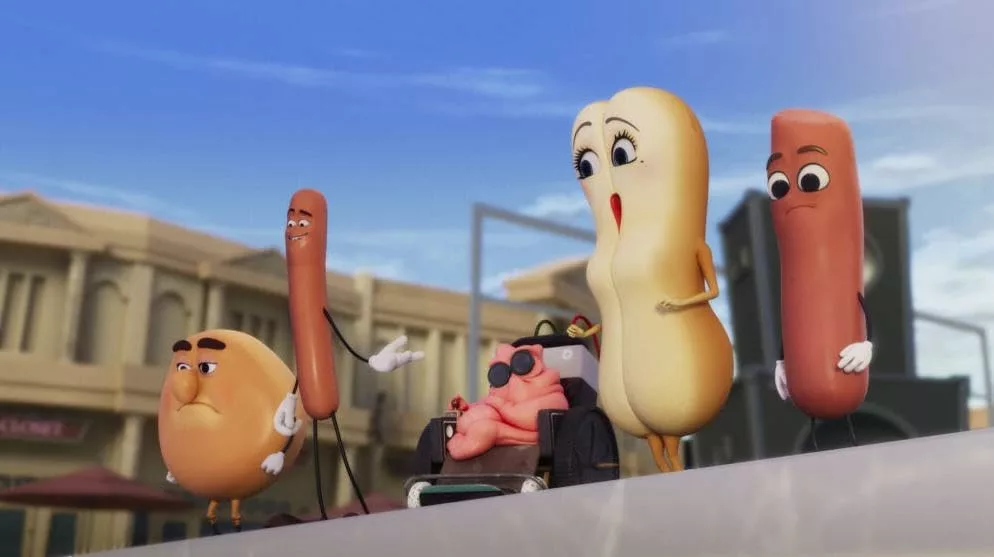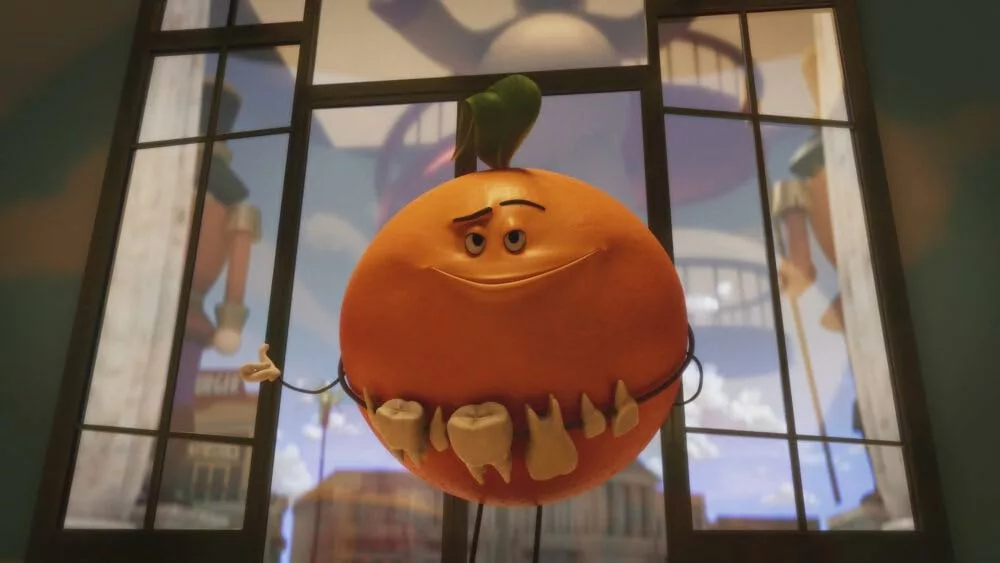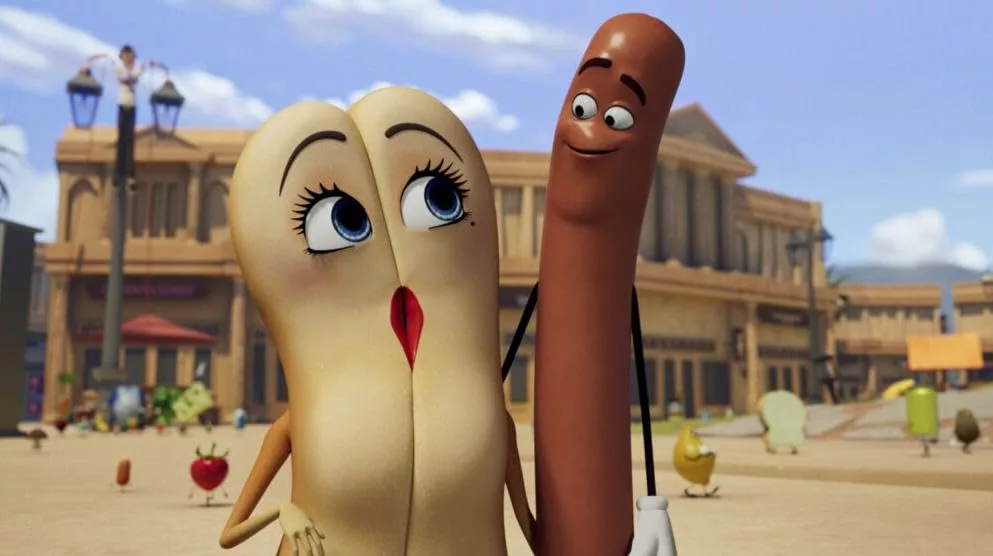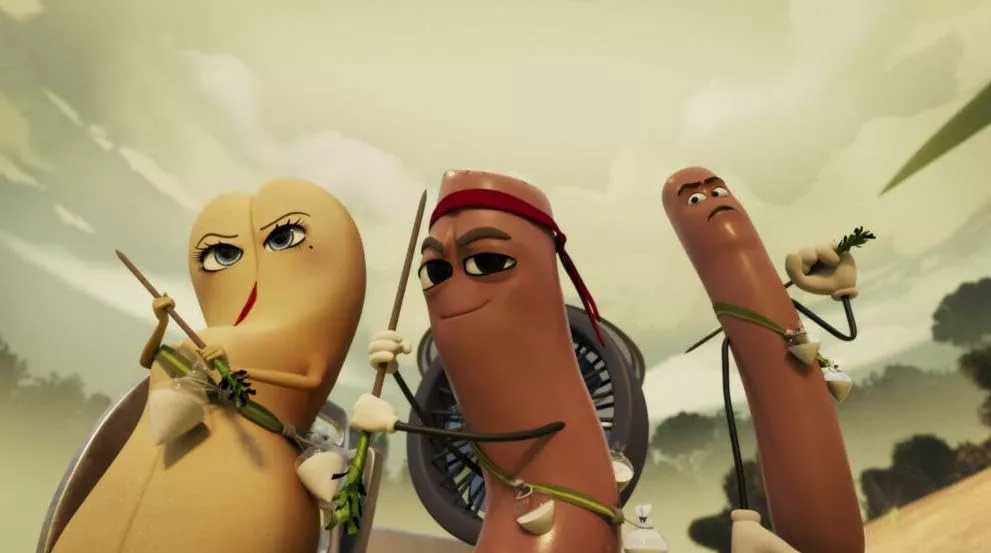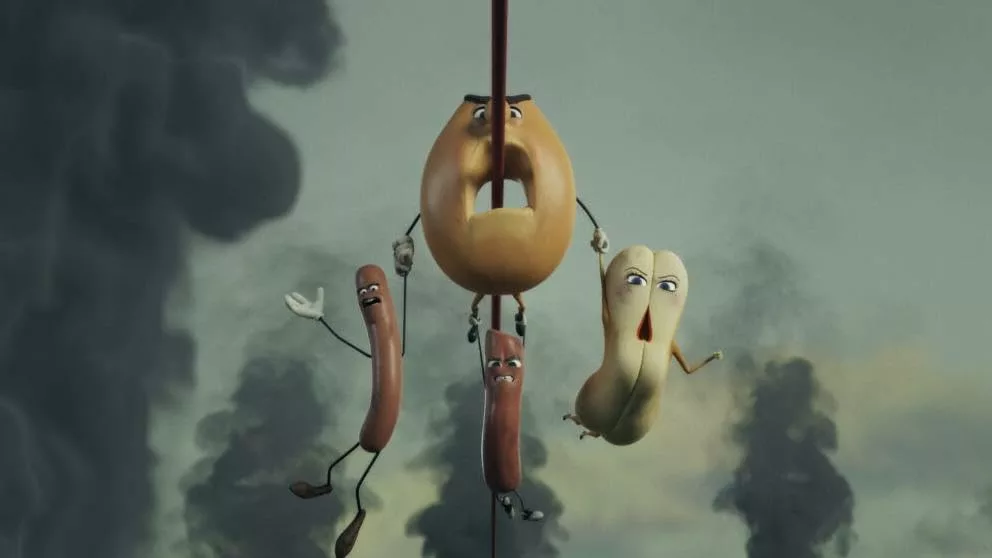The 2024 animated comedy Sausage Party took viewers by surprise with its audacious premise: a secret world where the food in our grocery stores lives, breathes, and has relationships, all while anxiously awaiting the day they’ll be “chosen” and leave the store. Of course, the sausages, bread, and other foods quickly discover that getting chosen means facing a grisly fate rather than paradise. The film was a bona fide hit, using humor both raunchy and clever to skewer society’s values and mores.
Fast forward a few years, and this unlikeliest of franchises has gotten another seat at the table in the form of Amazon Prime’s new series Sausage Party: Foodtopia. Picking up where the movie left off, it brings back the same starry voice cast as our food friends try to form a functioning society in the aftermath of their grocery store revolution. It’s anarchy, puns, and profound philosophizing about the human condition—just with a lot more inappropriate jokes involving fruits and vegetables.
Over the course of this review, we’ll take a closer look at the world of Foodtopia, breaking down each episode’s highlights and analyzing how the themes are shaping up. First up, an exploration of how society emerges for food in the aftermath of victory. Then, the struggle to find purpose and meaning after utopia is disrupted. We’ll examine the class warfare stirred up by a scheming orange and the musical escapades of a lovesick bagel. So pull up a seat, grab a snack if you dare, and dig in!
Setting New Standards
After achieving victory over the humans at Shopwell’s grocery store, Frank the hot dog and Brenda the bun were eager to start their new lives. But establishing a functioning society outside the confines they knew was no easy task. Foodtopia, the safe haven they hoped to create, was short-lived as a torrential downpour led to mass casualties.
As others looked to blame, Frank recognized they must find answers to survive. A captured human, Jack, was recruited to impart the outside world’s mysteries, like rainfall and menacing crows. Meanwhile, an orange named Julius saw opportunity in the chaos. Leveraging leftover human teeth as the new currency, he constructed a system that thrived on inequality. From his industrial refrigerator stronghold, Julius charged a toll to the less fortunate for basic needs.
Rising to power through manipulation, Julius’ capitalist regime divided the community. As wealth disparity grew, many people were left with little choice but to submit to his rule in exchange for shelter from the elements. An underground resistance formed with Frank, Brenda, and their friends to challenge Julius’ authoritarian grip.
Across episodes, they sought diplomatic solutions, but Julius only doubled down on control. A climactic showdown loomed to settle their competing ideologies for Foodtopia’s future. With the community’s well-being at stake, both sides prepared for what could be their final stand to determine if cooperation or competition would set the new standard. Through adventure and intrigue, the storyline expertly heightened these critical themes for modern society.
Foodtopia’s Familiar Favorites
It was great fun to catch up with Frank, Brenda, and the rest of the favorites from Sausage Party. Seth Rogen and Kristen Wiig slip effortlessly back into their roles as the hot dog Frank and bun Brenda, bringing their witty repartee and infectious chemistry. They are as charismatic a comedic duo as ever and clearly still love every minute of adventuring together.
Michael Cera lends his signature brand of awkward hilarity to runty wiener Barry. While small in stature, Barry more than makes up for it with his wild antics and scrappy determination. The odd duck character allows Cera to shine in a breakout performance that audiences won’t soon forget.
Among the highlights, though, is getting another dose of Sammy Bagel Jr., played brilliantly with neurotic zeal by Edward Norton. Grappling with love and loss, Sammy brings both comedic intensity and pathos. Whether spinning spirited puns or cutting loose in a celebratory musical number, Norton owns every scene with gusto.
Joining the fun this time is Will Forte in a standout role as the human prisoner Jack. An informative and amusing captive, Forte delivers perfectly deadpan responses to the foodsters’ bewilderment. His fish-out-of-water reactions provide plenty of laughs as events escalate beyond his control.
The returning performers slip back into their roles with easy chemistry while the new additions gel seamlessly. Character quirks and exaggerated personalities serve as fodder for hilarity as their journeys unfold. Audiences will eagerly await what further adventures this unforgettable ensemble will find themselves in.
Cinematographic Creations
The animated world of Foodtopia really comes alive. After establishing the sentient foods’ society within the confines of the grocery store in the film, the series transports viewers beyond those walls, and the animation rises to the occasion. The natural environments the foods now explore, from grassy fields to stormy skies, are vividly realized. Crisp designs showcase everything from fluttering crows to individual raindrops relentlessly assaulting the landscape.
Characters themselves remain a treat for the eyes. Expressive motions capture each food’s distinct personality, from Frank’s enthusiastic leadership to Sammy Bagel’s constant quest for attention. Graphic violence ups the R-rated ante too, whether it’s a crow tearingly dismantling its prey or a disastrous egg incident that leaves a runny mess. Yet even in their gore, each food feels fully formed.
While initial budgets likely curbed Sausage Party’s visual scope, its creators have utilized Prime Video’s capabilities to the fullest effect in Foodtopia. Smooth animations engage constantly, from dance routines to pitched brawls. Subtle flourishes also emerge, like how Barry’s distortion changes based on his mood. The luminous results prove streaming services can fuel animation that rivals big screens. By bringing its zany world to vibrant life, Foodtopia shows how far this fertile franchise has come.
Riotous Humor in Sausage Party: Foodtopia
The animated series Sausage Party: Foodtopia continues to push the boundaries of comedy established by its predecessor. Viewers are treated to crass jokes about finding new extremes of depravity, with bodily functions and debauchery displayed in graphic cartoon form. Yet this outrageousness is balanced by clever wordplay, as references to films, music, and more are reimagined through a lens of ripe punnery.
Character Sammy Bagel especially delights in springing fruitful jokes from mundane scenarios. One episode sees him attempt stand-up, blending pie-in-the-sky puns with down-to-earth observational humor mined from food folk’s everyday lives. Elsewhere, a musical number parodies beloved pop songs through modified lyrics fitting the cometible cast. Such moments lighten the mood following graphic gags, keeping uneven balances between crude and clever humor.
While striking crude poses, the series sincerely satirizes modern issues. It skewers late-stage capitalism by depicting an orange oligarch hoarding resources. As inequality grows between haves and have-nots, commentary emerges from absurd angles, like critiquing greed while characters literally eat the rich. Satire blossoms in grotesque domains, driving home a thought-provoking core beneath outrageous surfaces.
All the while, anarchic acts of animated violence enact foodstuffs meeting startling ends. Visceral visuals depict grapes bursting and eggs reduced to slip-and-slides of yolk. Yet such gross-out gags entertain through wild imagination more than mere shock value. Balance is found as crassness complements cleverness, with edgy extremism often resolving on upbeat and funny notes. Together, these elements continue the lively, provocative style that distinguishes Sausage Party’s offbeat vision.
Filmtopian Reflections
Within Foodtopia’s comedic chaos lies meaningful rumination. The transition from grocery confinement to a wider world sparks navigational growing pains as well as societal seeds that bloom in familiar yet frightening forms.
Frank, Brenda, and their crew boldly dreamed of equitable abundance, but heavy rains shattered dreams while illuminating dependencies. In empathy and reason, they found a humor holding answers, just as community requires contributing each capability. Yet not all embraced cooperation.
Julius flourished through a new economy of emotion-tied earnings, yet the wealth collected followed wealth’s usual contagion. Needs were met for some while insecurity spread for others, as those with much more convinced themselves that more was their due. But authority unbound by service risks mistaking subjects for supplies.
Now leaders vie to remedy or perpetuate divides, and viewers ponder what systems nourish all and what binds us instead of benefit. If utopias remain works in progress, perhaps progress remains our work. If we favor fixing flaws over finding fault, we should empower seasons of sharing over seasons of scrapping for scrap.
Through parody Foodtopia peers plainly at patterns across populations; nothing human is quite alien. Its merry misadventures magnify matters moving or troubling our world, raising laughs while quietly encouraging each person’s part in every community’s crafting. Whether we are governing groceries or globes, our fates are mutual.
Foodtopia Follows Through
Seth Rogen and company found a creative way to continue the story started in Sausage Party through this animated series. Picking up right where the movie left off, it’s great to catch up with Frank and the others as they try to build a new society in unpredictable times. The animated format gives them room to explore many wild ideas.
While some elements start to feel repetitive after a while, there’s no shortage of laugh-out-loud funny moments throughout. From musical numbers to stunt sequences copied from action movies, they pack each episode with memorable scenes that keep viewers engaged. Anyone who enjoys their outrageous brand of humor will get a real kick out of this amusing adventure.
Hardcore fans of the first film will especially get a kick out of seeing their favorite food characters again. Animation lovers will also appreciate the creative world and characters brought to life through the visuals. Not everything lands perfectly, but it’s obvious a lot of passion went into crafting this continuation of the story.
In the end, Foodtopia serves as another solid addition to Seth Rogen and Evan Goldberg’s extensive repertoire. While not groundbreaking, it delivers plenty of the crude jokes and imaginative concepts that their fans have come to love. For anyone in need of a lighthearted romp with some vulgarity mixed in, this series provides junk food for the brain.
The Review
Sausage Party: Foodtopia
While not without its flaws, Sausage Party: Foodtopia proves another delightfully ridiculous adventure from Rogen and company. Managing to expand the story creatively while retaining the spirit of the original, it delivers consistent laughs and never fails to entertain.
PROS
- Continues story creatively from the first film
- Packed with laughs and crude humor
- Interesting concepts explored in developing a new society
- Memorable characters and performances
CONS
- Some elements feel repetitive over a longer format.
- Satire and social commentary can be ham-fisted.
- The plot is not as tight or cohesive as the film at times.









































